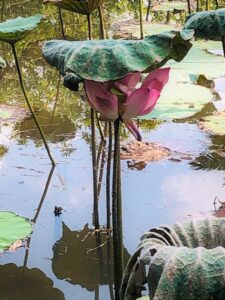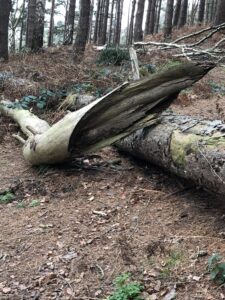Zen Flowers
Put most simply, Zen is a calm, peaceful state of being that you can use to rest and observe in. You can also use it to create a state of ‘dynamic calm’ within which you do your daily activities; weathering your storms with it and enhancing your joys and victories.

This article contains three simple ways you can cultivate an inner ‘Zen’ space in your own meditation. They are imaginative and experiential. You won’t find then in any Zen manuals (that I know of), they are my own techniques, but they are consistent with the spirit of Zen practice. Practiced together they are designed to give us a kind of ‘initiation’ into the experience of Zen. They will give you something new, even though you may know nothing about Zen, or are already a seasoned practitioner.
Building an inner Zen retreat space
Spend a little bit of time sitting quietly and using your intuitive imagination to build your own ‘Zen Retreat’. This is simply an imaginal or imagined place that helps you to connect more strongly with the spirit of Zen. The way in which you perceive it is very much up to you. It could be like a mountain monastery type scene, or simply a special place in nature that we feel somehow embodies the spirit on Zen. Trust your intuition here, and be confident that whatever you see/feel/hear around you was perfect for you, and your understanding of what Zen is.
Meeting a Zen Guide
Set your intention within your retreat to meet your own ‘Zen guide’ or teacher. Imagine s/he comes to meet you. It may be someone that you have never met before, or it may be a figure that you know, either from your literal past, or a figure from a story or myth that you love. Your Zen guide is someone that you build within our imagination. Trust your intuition to give us an appropriate visual for the energy of your Zen guide. S/he could be a lay person or ordained, young or old.
Journeying to the origins of Zen
After connecting with your guide for a while, let them guide you on a journey back in time to the origins of Zen, which was a teaching that Buddha gave, called the Flower Sermon.
Toward the end of his life, the Buddha took his disciples to a quiet pond for instruction. As they had done so many times before, the Buddha’s followers sat in a small circle around him, and waited for the teaching.
But this time the Buddha had no words. He reached into the muck and pulled up a lotus flower. And he held it silently before them, its roots dripping mud and water.
The disciples were greatly confused. Buddha quietly displayed the lotus to each of them. In turn, the disciples did their best to expound upon the meaning of the flower: what it symbollized, and how it fit into the body of Buddha’s teaching.
When at last the Buddha came to his follower Mahakasyapa, the disciple suddenly understood. He smiled and began to laugh. Buddha handed the lotus to Mahakasyapa and began to speak.
“What can be said I have said to you,” smiled the Buddha, “and what cannot be said, I have given to Mahakashyapa.”
Mahakashyapa became Buddha’s successor (in the Zen lineage) from that day forward.
Spend some time contemplating your own initial impressions of this story, before returning to awareness of being with our Zen guide in your retreat. Your Zen guide then gives you a personal gift to welcome you into the spirit of Zen. The gift is known only to you. You may understand immediately what the object or gesture means, or it may be something for you to take away with you and contemplate. Then finish the meditation after saying goodbye to your guide.
Your Zen retreat then becomes a place that you can go to further deepen your experience if meditation in the spirit of Zen, and to meet and meditate with your guide and the gift that s/he gave to you.
Related article: Four Zen meditations
Article & content © Toby Ouvry 2021, you are welcome to use or share this article, but please cite Toby as the source and include reference to his website www.tobyouvry.com
 Starts 6th&7th July – Integral Meditation from the Perspective of Zen – A 10 week series
Starts 6th&7th July – Integral Meditation from the Perspective of Zen – A 10 week series
In a sentence: De-clutter your mind, develop concentration and create focused calm in your life by learning Zen meditation
Overview: The Zen School of Meditation arose from a combination of the teachings of the Buddha with the teachings of Taoism in China during the 6th century AD, where it became known as Chan meditation (‘Chan’ meaning ‘quietude’, or ‘meditation’). Later it was adopted by the Japanese, and it is they that called it Zen.
Zen is a particularly appropriate form of meditation for today’s hyper busy and challenging world because…Read full course details
 Weekend of 9,10,11th July – The Integral Mindfulness Program for Coaches, Counselors & Therapists – Creating sustainable high performance and & wellness
Weekend of 9,10,11th July – The Integral Mindfulness Program for Coaches, Counselors & Therapists – Creating sustainable high performance and & wellness
Overview: This is a weekend, three-session dynamic mindfulness program designed for:
- Those looking for an engaged, practical mindfulness course designed to build resilience, effectiveness and wellness in the face of work and life challenges
- Trainers, coaches and therapists looking to integrate mindfulness into their own professional practice with clients
- People who have been through basic conventional mindfulness training programs and are looking for the next level of practice and performance
The essential content of the course is ten separate but interlinked mindfulness meditation practices…
Read full details
 Saturday 17th, 24th, 31st July, 2-4pm – Mindful Life-skills for Teenagers – A three week courseThese sessions are specifically designed to help teens develop their real inner skills that help them be:
Saturday 17th, 24th, 31st July, 2-4pm – Mindful Life-skills for Teenagers – A three week courseThese sessions are specifically designed to help teens develop their real inner skills that help them be:
- More effective at achieving their chosen goals
- Build confidence,
- Build resilience around stress and
- Increase their capacity for fun and enjoyment as they learn.
 The new Mindful Self Knowledge coaching programThis is eight-month coaching program with Toby is designed to facilitate your own personal mindful self-discovery process. It focuses on:
The new Mindful Self Knowledge coaching programThis is eight-month coaching program with Toby is designed to facilitate your own personal mindful self-discovery process. It focuses on:
- Awareness of how your past experience has influenced who and how you are today
- Confidence in approaching your present experience with playful fullness and enthusiasm
- Giving you the inner tools to face your choices and your future in an empowered, dynamic, and authentic manner
Watch Toby’s video on the Program
 Life-fullness – The Integral Life-Coaching Program with Toby
Life-fullness – The Integral Life-Coaching Program with TobyAre you looking a coach who can help you to:
- Meet the challenges, stress and changes that you face in a more effective and mindful way
- Become happier within yourself, in your relationships and at work
- Be actively accountable for finding a sense of balance/well-being in your life and fulfilling your personal potential?
- Guide you to find and operate from a deeper sense of meaning, motivation and connectivity in your life?
All upcoming classes and workshops at IMA:
Ongoing – Weekly Tuesday, Wednesday Online class schedule
Ongoing on Wednesday’s, 7.30-8.30pm – Wednesday Meditation for stress transformation and positive energy with Toby (Bukit Timah)
Ongoing on Tuesday evenings, 7.30-8.30pm – Tuesday Meditation for stress transformation and positive energy with Toby (East Coast)
Starts 6th&7th July – Integral Meditation from the Perspective of Zen – A 10 week series
Weekend of 9,10,11th July – The Integral Mindfulness Program for Coaches, Counselors & Therapists – Creating sustainable high performance and & wellness
Saturday 17th, 24th, 31st July, 2-4pm – Mindful Life-skills for Teenagers – A three week course
Saturday 24th July, 9.30-11.30am – Mindfulness for emotional intelligence masterclass
Integral Meditation AsiaOnline Courses * 1:1 Coaching * Books * Live Workshops * Corporate Mindfulness Training *Life-Coaching * Meditation Technology
 Dear Integral Meditators,
Dear Integral Meditators,







 Audio Serenity
Audio Serenity


 Zen Meditation – Seeing Without Naming
Zen Meditation – Seeing Without Naming